If you and your partner live a busy life, chances are, date nights often slip through the cracks. Between work demands, household chores, and the whirlwind of responsibilities, it’s easy to let these special evenings fade into the background.
But who says date nights should be confined to only Valentine’s Day or anniversaries? You can plan a date night in the comfort of your own home.
The idea of cooking for a date night may seem intimidating. After all, we all want to sweep our partners off their feet with something special and delicious. That’s where fancy Filipino dishes come in.
These recipes combine incredible flavors, vibrant colors, and impressive presentation to create the perfect date night meal.
So put on your apron and get ready to impress your partner with these fancy dishes.
Beef Salpicao
Say goodbye to boring beef stir fries with beef salpicao. This flavorful dish is made with tender cubes of beef marinated in a savory blend of soy sauce, Worcestershire sauce, garlic, and spices.
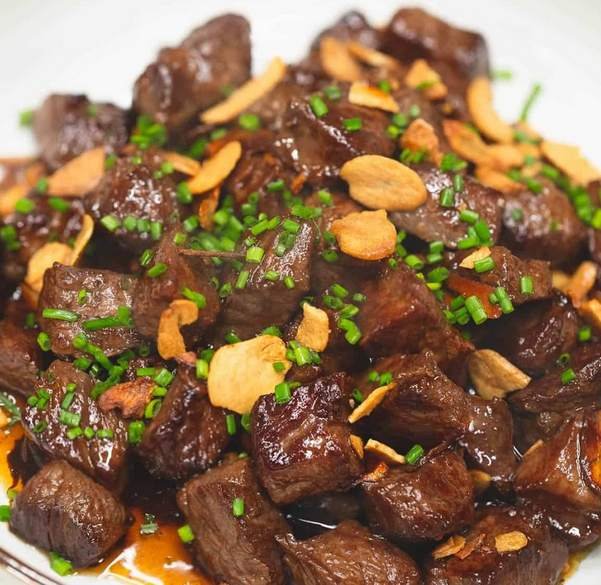
The beef is then quickly seared to perfection, resulting in a juicy and succulent dish that will make your taste buds dance with delight.
You can serve beef salpicao on a sizzling plate with toasted garlic or confit garlic for an extra punch of flavor. The crispy garlic adds a delightful crunch to every bite, while the confit garlic brings a rich and mellow sweetness that complements the savory beef.
For an added touch of elegance, serve the beef salpicao on a bed of buttery mashed potatoes and garnish it with fresh parsley. The creamy texture of the potatoes will complement the flavors of the beef and create a balance that will surely impress your partner.
Menudo
There’s something about the rich tomato-based dishes that inspires comfort. Menudo, a classic Filipino dish, is the perfect way to create that atmosphere for your date night. Its hearty combination of pork, liver paste, and vegetables will definitely leave you in awe.

To make this dish truly special, start by sautéing onions and garlic in a deep pan until they turn transparent. This will infuse the base of the dish with a deeply satisfying flavor.
Next, add chunks of succulent pork and cook until they are beautifully browned on all sides. The caramelization of the meat will add a depth of flavor to the menudo.
Once the pork is cooked to perfection, it’s time to add the star of the show – the liver paste. This adds a velvety texture that melts in your mouth, elevating the overall experience of the menudo.
To balance out the richness, toss in colorful vegetables such as carrots, potatoes, and bell peppers. Not only will they add vibrant hues to the dish, but they will also provide a crunchy and fresh contrast to the tender meat. Serve this with warm rice to complete the meal.
Chicken Adobo
It would be an understatement to say that chicken adobo is a staple in Filipino cuisine. This beloved dish has stood the test of time and has become a symbol of comfort and home. So, why not impress your partner with a fancy twist on this classic?
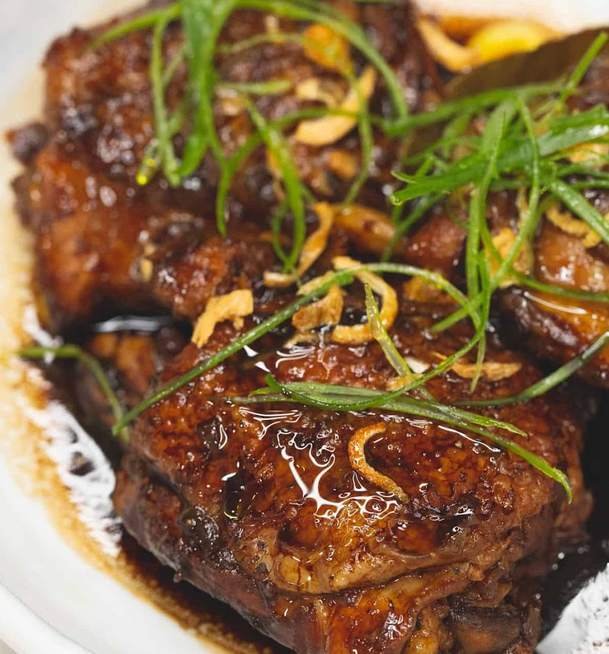
To start, gather your ingredients: chicken pieces, soy sauce, vinegar, garlic, bay leaves, and peppercorns. The beauty of Chicken Adobo lies in its marinade, which infuses the meat with a tangy and savory flavor profile.
In a mixing bowl, combine soy sauce, vinegar, minced garlic, crushed peppercorns, and a couple of bay leaves. Give it a good stir to ensure that all the flavors are well incorporated.
Place the chicken pieces in the marinade, making sure each piece is coated evenly. Cover the bowl with plastic wrap and let it marinate in the refrigerator for at least an hour, or even overnight if you have the time.
When you’re ready to cook, heat a large skillet over medium-high heat and add a dash of oil. Carefully place the chicken pieces in the pan, skin side down.
Allow them to brown and crisp up for a few minutes before flipping them over to cook the other side to create a beautiful golden crust that adds both texture and flavor to the dish.
Once done, transfer the chicken pieces to a plate and set them aside. In the same skillet, pour in the marinade along with a splash of water to deglaze the pan and scrape up all the flavorful bits stuck to the bottom.
Let the liquid come to a gentle simmer before returning the chicken pieces back into the pan. Reduce the heat to low, cover, and let the chicken simmer in the sauce for about 20 minutes, or until it becomes tender and infused with all the aromatic flavors.
Beef Caldereta
If you’re in the mood for a hearty and indulgent dish that will leave your partner speechless, look no further than beef caldereta. This Filipino dish is a true showstopper that combines tender chunks of beef with a rich and flavorful tomato-based sauce.

Caldereta is a dish that demands time and attention to detail, but the end result is well worth the effort.
Start by cooking the carrots, potatoes, and bell pepper, but don’t forget to take into consideration the time it will take for each vegetable to reach the perfect level of tenderness. You may also do this in another pan while the beef is cooking.
Once the vegetables are cooked, proceed to brown the beef chunks in a hot pan, allowing them to develop a deep, caramelized crust. This step is crucial in building layers of flavor that will elevate the dish to new heights.
Add the rest of the ingredients including the tomato sauce, beef cube, onions, liver spread, and red bell peppers to the pan with the browned beef. These ingredients will contribute to the rich and savory base of the caldereta sauce.
If you want this dish to be more indulgent, add mozzarella on top and broil it in the oven for three to five minutes. Pair this dish with a bottle of full-bodied red wine.
Kare Kare
Kare Kare is a Filipino dish that is often associated with special occasions and celebrations. It is a uniquely flavorful stew made from oxtail, tripe, or beef, cooked in a thick and creamy peanut sauce. The combination of tender meat, vegetables, and the nutty flavor of the sauce creates a dish that is very satisfying.
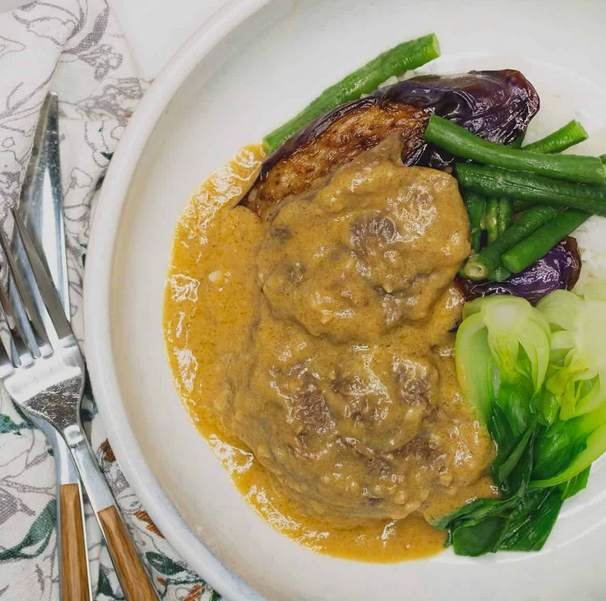
A deconstructed kare kare is the perfect way to add a modern twist to this classic Filipino dish. Instead of serving it as a stew, you can present each element separately on a plate, allowing your partner to build their own personalized Kare Kare experience.
To start making kare kare, prepare the oxtail or beef by boiling it until it becomes tender. This process may take some time, but it is essential to achieve the melt-in-your-mouth texture that is characteristic of this dish.
Once the meat is cooked, set it aside and let it cool for a few minutes. While waiting, prepare the vegetables that will accompany the Kare Kare. Traditionally, bok choy, eggplant, and string beans are used but feel free to use any vegetables that you and your partner enjoy.
Then, start making the sauce which is the heart of this iconic dish. To make the sauce, infuse the cooking oil with vibrant annatto seeds, and sauté garlic and onions in this tinted oil.
This sets the stage for the star of kare kare: peanut butter. Mix it with ground toasted rice and watch it thicken gradually upon adding beef or vegetable broth. Finally, simmer it gently until it reaches the desired consistency.
Once the sauce is ready, it’s time to assemble the deconstructed Kare Kare. On a large serving platter, arrange the tender oxtail or beef in a neat pile. Place the blanched bok choy, steamed eggplant, and blanched string beans in separate sections around the meat.
Put the sauce in a bowl or gravy boat and serve it alongside the platter. This allows your partner to drizzle as much or as little sauce as they desire over their chosen ingredients.
You can also sprinkle some toasted crushed peanuts on top of the meat and vegetables. The crunchiness of the peanuts adds a delightful textural contrast to the dish and adds a nutty flavor that pairs well with the creamy peanut sauce.
Bistek
Bistek starts with thinly sliced beef sirloin that is marinated in a mixture of soy sauce, calamansi juice, and minced garlic. This marinade not only adds flavor to the meat but also helps to tenderize it, ensuring that each bite is succulent.
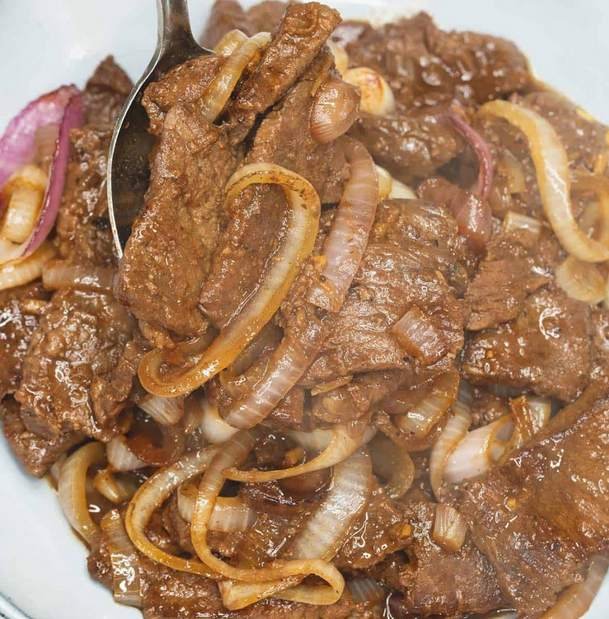
After marinating the beef for at least 30 minutes, heat a skillet over medium-high heat and add a drizzle of oil. Once hot, carefully place the beef slices in a single layer and let them sear for a few minutes on each side until they brown.
To complete the dish, reduce the heat to medium and pour in the remaining marinade. Allow the beef to simmer in the sauce, absorbing all the flavors and becoming even more tender.
As the liquid reduces, it will transform into a glossy glaze that coats each slice of beef, creating a mouthwatering caramelized coating.
While the beef is simmering, take this opportunity to prepare the accompanying onions. Thinly slice the red onion into rings and separate them. Put them in iced water to add a crisp and refreshing element to the dish. This will help balance out the richness of the beef and add a subtle bite.
Once the beef is cooked to perfection and the sauce has reduced, plate up the bistek. Arrange the seared beef slices on a serving platter and pour any remaining sauce over the top. Finally, scatter the onions over the beef.
Gambas
Seafood lovers will surely be delighted by the flavors of Gambas, a classic Spanish dish that showcases the natural sweetness of shrimp combined with garlic and a hint of spice.
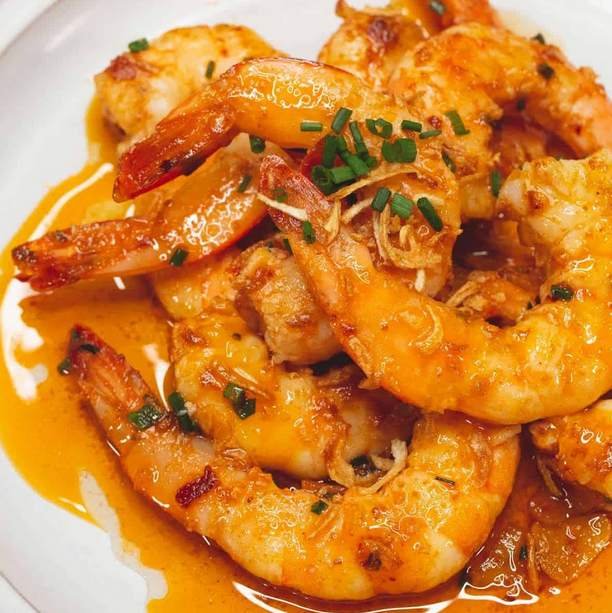
To prepare this simple yet delicious dish, start by cleaning and deveining fresh shrimp. Leave the tail intact to enhance the presentation and provide convenience when enjoying this food. Pat the shrimp dry with a paper towel to ensure a crispy texture when cooked.
Next, heat olive oil in a pan and add minced garlic and thinly sliced chili peppers. Once the garlic starts to turn golden brown, it’s time to add the shrimp. Carefully place each piece into the sizzling pan, making sure not to overcrowd them.
This allows the shrimp to cook evenly and develop a beautiful sear on the outside while remaining tender and juicy on the inside.
Finish off this dish by squeezing some fresh lemon juice over the cooked shrimp. The tangy acidity of the lemon brightens up the flavors and adds a refreshing twist to the dish. Sprinkle a handful of chopped parsley on top for a pop of color and a hint of earthy freshness.
Pair this mouthwatering Gambas with a crusty baguette or a bowl of steaming white rice to soak up all the delicious flavors. For drinks, consider serving a crisp white wine or a light and refreshing cocktail.
The vibrant flavors of the Gambas will be complemented by the fruity notes of a Sauvignon Blanc or the zesty citrus undertones of a Mojito.
Escabeche
This dish is perfect for those who enjoy a balance of acidity and sweetness in their meals. To prepare Escabeche, choose a firm white fish such as Red Snapper, Tilapia, Pompano, Lapu-Lapu, or Tanigue.
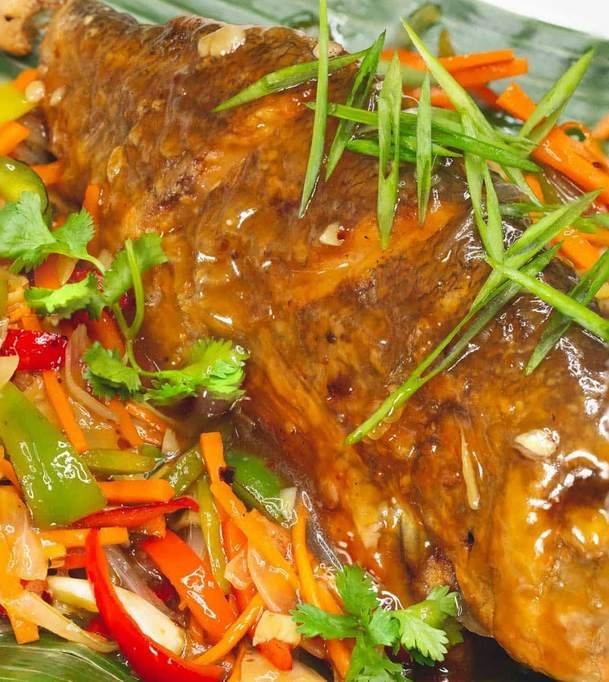
Clean the fish thoroughly and make diagonal incisions on both sides. Season it with salt and pepper, ensuring that the flavors penetrate the flesh. In a large skillet, heat some oil over medium-high heat and carefully place the fish in the pan. Let it cook for a few minutes on each side until it browns.
While the fish is cooking, prepare the escabeche sauce. In a separate saucepan, heat some oil and sauté sliced onions until they become translucent and fragrant. Add minced garlic and grated ginger to the pan, stirring them in to release their flavors.
Then, pour in a mixture of vinegar, soy sauce, and a touch of sugar. Allow the sauce to simmer gently, allowing the flavors to meld together and the sugar to dissolve completely.
As the sauce simmers, add sliced bell peppers and carrots to the pan, stirring them in to coat with the sauce. These vegetables will provide a vibrant crunch and add a touch of sweetness to the escabeche. Let them cook until they are slightly tender but still retain their crispness.
Once the fish has developed a golden crust on both sides, carefully transfer it to a plate and set it aside.
Pour the simmering escabeche sauce over the cooked fish. The sauce will infuse the fish with its tangy and sweet flavors. Finally, garnish the dish with some chopped cilantro or parsley.
Pata Tim
Pata Tim is a classic Filipino recipe that features melt-in-your-mouth tender pork leg simmered in a rich and flavorful sauce. It’s perfect for special occasions or when you’re craving a hearty and comforting meal.

You’ll need a large pork leg for this recipe, preferably with the bone-in to add depth of flavor. Begin by thoroughly cleaning the pork leg and patting it dry. In a large, heavy-bottomed pot, boil the pork in water and instant coffee.
Don’t worry – your meat won’t taste like coffee. Once done, remove the liquid from the pot. Add coca cola or any soda with bay leaves, garlic, onion, salt, water, and a chicken cube and boil the meat again until it becomes tender all the way through.
After this step, it’s time to prepare the sauce. In a separate saucepan, combine garlic, onion, bell pepper, soy sauce, and the cola mixture from the last pot with the pork leg.
The richly flavored sauce will penetrate the pork, infusing it with its aromatic goodness as it simmers away. Cover the pot with a lid and let it cook on low heat until the sauce thickens.
As the Pata Tim cooks, take this opportunity to prepare some tasty accompaniments. Steam some bok choy until it becomes tender and prepare some rice.
After several hours of simmering, you’ll notice that the pork leg will become incredibly tender and almost fall off the bone.
Paella
A classic Spanish dish, paella is a delightful and vibrant one-pot meal that showcases the flavors of the Mediterranean. Traditionally cooked over an open flame, this rice-based dish is perfect for bringing people together, as it can be shared among family and friends.

To start preparing paella, gather all the necessary ingredients. Saffron threads are an essential component of this dish, as they lend their distinct aroma and golden hue to the rice. Soak the saffron threads in a small amount of warm water to extract their full flavor.
In a large, shallow paella pan, heat some olive oil over medium-high heat. Add diced onions and sliced bell peppers to the pan, sautéing them until they become soft and translucent.
The onions will release their natural sweetness, while the bell peppers will add a pop of color and crunch to the dish.
Next, add diced tomatoes to the pan, stirring them in with the onions and bell peppers. The tomatoes will break down and create a rich base for the paella, adding depth of flavor to the dish.
Once the tomatoes have cooked down slightly, it’s time to add the rice. Use a short-grain variety since it can absorb liquid without turning mushy. Stir the rice into the pan.
Now, it’s time to add the star ingredient of paella: the broth. Use a high-quality chicken or vegetable broth to enhance the flavors of the dish. Slowly pour the broth into the pan, making sure that it evenly covers the rice. The liquid will gradually be absorbed by the rice for added flavor.
As the rice cooks, it’s important to resist the urge to stir. This allows the bottom layer of rice to develop a crispy crust known as “socarrat.” This burnt layer adds a delightful crunch to the paella.
While the rice simmers, add the proteins and vegetables that will complete the dish. Arrange succulent shrimp, juicy chicken pieces, and savory chorizo slices on top of the rice.
Nestle them into the rice, allowing them to cook and release their juices, which will further enhance the flavors of the paella. Finally, scatter vibrant green peas and roasted red peppers across the pan.
Sinigang na Salmon
Want to stay at home on a rainy day with your loved one? Sinigang na Salmon is the perfect dish to warm your hearts and souls. This Filipino sour soup features tender salmon head or belly cooked in a tangy tamarind broth, with an array of vegetables that add freshness.

Salmon provides a delicate and flaky texture that pairs perfectly with the sour broth. To make the broth, start by sautéing some onions and garlic in a large pot until they become fragrant and translucent. Add sliced tomatoes and gently stir them into the onions and garlic. Then, add water.
Tamarind is the key ingredient that gives sinigang na Salmon its distinct sour taste. You can also purchase sinigang mix if you can’t get tamarind paste.
Next, bring the broth to a gentle simmer. The tomatoes will break down and release their natural sweetness, balancing out the tartness of the tamarind. Now, it’s time to add the vegetables that will complement the salmon and make this dish a wholesome meal.
Toss in some fresh green beans, sliced radishes, and leafy kangkong or water spinach. Let the soup simmer gently. Throw in some long green chili peppers for a hint of spice.
Once the vegetables are cooked to perfection, carefully place the salmon back into the pot, gently nestling them among the vegetables. Let them simmer for a few more minutes, just until they are heated through and have absorbed some of the tangy flavors from the broth.
Crispy Pata
A crispy, deep-fried, golden brown pork leg that is tender on the inside and crispy on the outside, Crispy Pata is a beloved Filipino dish that never fails to satisfy. The process of achieving the perfect texture and flavor begins with selecting a high-quality pork leg.

Make sure it is fresh and has a good amount of fat since this contributes to the succulence of the dish.
The secret to achieving a crispy exterior lies in the preparation and cooking method. Start by thoroughly cleaning the pork leg to remove any hairs or impurities. Using a sharp knife, make several deep slits into the meat, allowing the flavors to penetrate deeper.
When you’re ready to cook, fill a large pot with water and bring it to a boil. Carefully lower the pork leg into the pot. Add some aromatics like bay leaves, whole peppercorns, and sliced onions to the pot to enhance the flavor of the pork.
Reduce the heat to a simmer and let the pork cook for about 2-3 hours until it becomes fork-tender.
Once the pork is cooked, carefully remove it from the pot and set it aside to cool. This step will help dry out the skin, ensuring that it becomes extra crispy when fried.
While the pork is cooling, heat a generous amount of oil in a deep fryer or a large pan. The oil should be hot enough to create a sizzle when the pork is added.
Fry the pork leg in the hot oil, carefully lowering it into the pan.
Allow the pork to fry until the skin is golden brown and crispy, turning it occasionally to ensure even cooking. This process can take anywhere from 20-30 minutes, depending on the size of the pork leg.
Once the pork leg is beautifully crispy, carefully remove it from the hot oil and set it on a wire rack or a plate lined with paper towels to drain any excess oil. Doing this also ensures your crispy pata won’t turn soggy. After letting the meat rest, slice it into thick pieces.
Don’t skip the sauce that accompanies Crispy Pata since it’s what takes this dish to the next level. In a small bowl, combine soy sauce, vinegar, minced garlic, chopped onions, and a sprinkle of sugar.
Stir everything together until the sugar dissolves and the flavors meld. Adjust the seasoning to your liking by adding more soy sauce or vinegar if desired.
Crispy pata is a very popular beer pairing, so you can shop for some craft beers or lagers to enjoy with this delectable dish.
Author Bio:
Nora Reyes, a formally trained chef, is the creative force behind “Recipes by Nora,” a blog devoted to sharing personally tested and perfected Filipino food recipes. Raised in a Filipino-Chinese household in Naga City, Philippines, Nora honed her culinary expertise from a young age. With over ten years of immersion in the food and hospitality sector, she has held positions such as a training director at a prominent restaurant chain in New York City, a restaurant consultant, and a private chef.
Nora’s culinary creations harmonize traditional Filipino approaches with contemporary techniques, showcasing both her cultural roots and culinary arts training.
